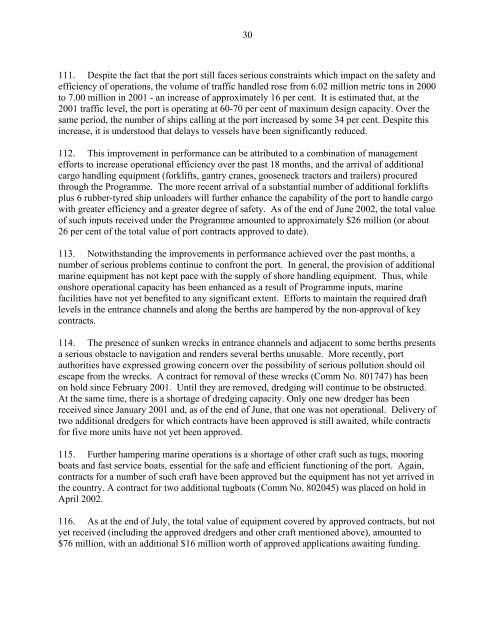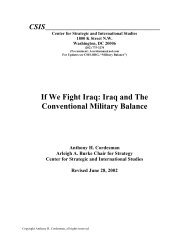I. Introduction II. Revenue generation
I. Introduction II. Revenue generation
I. Introduction II. Revenue generation
You also want an ePaper? Increase the reach of your titles
YUMPU automatically turns print PDFs into web optimized ePapers that Google loves.
30111. Despite the fact that the port still faces serious constraints which impact on the safety andefficiency of operations, the volume of traffic handled rose from 6.02 million metric tons in 2000to 7.00 million in 2001 - an increase of approximately 16 per cent. It is estimated that, at the2001 traffic level, the port is operating at 60-70 per cent of maximum design capacity. Over thesame period, the number of ships calling at the port increased by some 34 per cent. Despite thisincrease, it is understood that delays to vessels have been significantly reduced.112. This improvement in performance can be attributed to a combination of managementefforts to increase operational efficiency over the past 18 months, and the arrival of additionalcargo handling equipment (forklifts, gantry cranes, gooseneck tractors and trailers) procuredthrough the Programme. The more recent arrival of a substantial number of additional forkliftsplus 6 rubber-tyred ship unloaders will further enhance the capability of the port to handle cargowith greater efficiency and a greater degree of safety. As of the end of June 2002, the total valueof such inputs received under the Programme amounted to approximately $26 million (or about26 per cent of the total value of port contracts approved to date).113. Notwithstanding the improvements in performance achieved over the past months, anumber of serious problems continue to confront the port. In general, the provision of additionalmarine equipment has not kept pace with the supply of shore handling equipment. Thus, whileonshore operational capacity has been enhanced as a result of Programme inputs, marinefacilities have not yet benefited to any significant extent. Efforts to maintain the required draftlevels in the entrance channels and along the berths are hampered by the non-approval of keycontracts.114. The presence of sunken wrecks in entrance channels and adjacent to some berths presentsa serious obstacle to navigation and renders several berths unusable. More recently, portauthorities have expressed growing concern over the possibility of serious pollution should oilescape from the wrecks. A contract for removal of these wrecks (Comm No. 801747) has beenon hold since February 2001. Until they are removed, dredging will continue to be obstructed.At the same time, there is a shortage of dredging capacity. Only one new dredger has beenreceived since January 2001 and, as of the end of June, that one was not operational. Delivery oftwo additional dredgers for which contracts have been approved is still awaited, while contractsfor five more units have not yet been approved.115. Further hampering marine operations is a shortage of other craft such as tugs, mooringboats and fast service boats, essential for the safe and efficient functioning of the port. Again,contracts for a number of such craft have been approved but the equipment has not yet arrived inthe country. A contract for two additional tugboats (Comm No. 802045) was placed on hold inApril 2002.116. As at the end of July, the total value of equipment covered by approved contracts, but notyet received (including the approved dredgers and other craft mentioned above), amounted to$76 million, with an additional $16 million worth of approved applications awaiting funding.
















